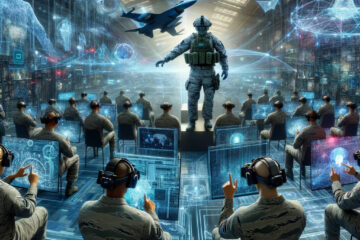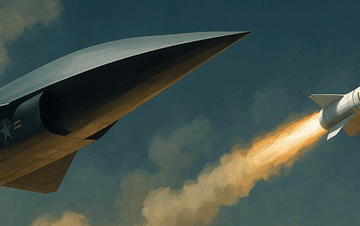Following the Cold War, there was much intellectual confusion concerning nuclear weapons, nuclear strategy, and why nuclear weapons exist. After the end of the Cold War, people around the world thought that it was the end of great-power competition; there would be no more threat of major conventional or nuclear war between great powers. The international system was fundamentally changed to a unipolar world. Humans were fundamentally changed and it was the end of history. For historians, the end of the Cold War would be rather inconsequential in the broader history of human conflict.
The world is now reminded of the normality of war in human existence by the aggression of revisionist Russia and China. The United States, leader of the free world, must once again deter the aggression of authoritarian regimes. This time, however, the United States is no longer in the same dominant position it once held.
American nuclear deterrence plays a critical role in managing the modern international system—the latest iteration of which is tripolar. Whilst many analysts in the arms control and disarmament community accuse those in the deterrence community of “Cold War thinking,” they make grossly inaccurate assertions that poorly reflect reality. The Cold War, which placed much of the world on the precipice of a nuclear exchange, generated unprecedented strategic thinking about how to manage great-power relationships and deter war between them.
The concepts underpinning deterrence: second strike, damage limitation, escalation control, delegation authority, and many others, are concepts that remain relevant today and require a careful re-thinking as the tripolar era moves forward. The implications of new technologies like effective missile defenses, hypersonic glide vehicles, and drones may change perceptions in unexpected ways.
Members of the academic and think tank communities were warning governments over a decade ago about the impending return of great-power competition in both Europe and the Asia-Pacific. There is a benefit to studying history. It is the ability to see trends without assuming they are certain to repeat themselves. The constancy of human nature, however, makes Thucydides’ admonitions equally useful today as they were 2,500 years ago.
It is time to re-think how to apply the classic strategic theories and concepts that aided in navigating the first nuclear age. They can aid the West in successfully navigating this era of tripolar superpower competition.
The bipolar Cold War construct was a unique development in history. This construct of two nuclear-armed superpowers competing for global influence was the new dynamic of what international great-power competition looked like historically. What appeared to be a global competition, was, in practice, a regional one focused on Western Europe and NATO, with second- and third-order effects for the rest of the world. The Asia-Pacific primarily received the leftovers in terms of the consequences and interests in the Cold War.
Thinking about concepts such as strategic stability, deterrence, extended deterrence, and arms control (developed during the Cold War) as the West contemplates confrontation across both Europe and the Asia-Pacific is a challenge. This is especially important as China ramps up its aggressive activity in the South China Sea, expands its nuclear arsenal, and builds a military specifically designed to defeat the United States.
The prospect of war between the great powers raises the question of how America’s post-war alliances, formed at the dawn of the nuclear age, might endure and function in such a world. Strategic concepts and connotations of the first nuclear age will have to be re-conceptualized to formulate strategies that reassure allies and deter adversaries. Ultimately, the credibility of American extended deterrence may not endure as the world enters a period akin to what William Walker termed nuclear disorder.
Walker suggests that the establishment, in the late 1960s, of nuclear order was based on managed systems of deterrence and abstinence. The former was a system whereby a recognized set of states would continue using nuclear weapons to prevent war and maintain stability, but in a manner that was increasingly controlled and rule bound. There was a degree of familiarity in the dyadic deterrence relationship of the United States and the Soviet Union.
Nuclear abstinence consisted of a system whereby other states give up sovereign rights to develop, hold, and use such weapons in return for economic, security, and other benefits. This took place concomitantly with the provision of a nuclear umbrella and a stable Nuclear Non-Proliferation Treaty (NPT). It is a system whereby not only the possession but also the use of nuclear weapons is controlled. According to Walker, the stability and robustness of these two systems provided the rationale for many states in the international system to abstain from acquiring weapons and for several key states to rely on American extended deterrence for their national survival.
There are several elements that characterise the nuclear order underpinning the structural foundations for the credibility of that extended deterrence. First, the number of nuclear weapons states is relatively small. Second, nuclear weapons are no longer considered bigger and better conventional weapons—as they once were. Third, there are strong norms against possession and use of nuclear weapons. Fourth, there are no existential threats to American allies. Fifth, war between major powers is relatively unlikely—even with Russian threats.
In the mid-2000s nuclear order began unravelling. That process increased in speed with the invasion of Ukraine and China’s nuclear breakout. With this came a need to re-think the strategic theory and concepts that helped navigate the first nuclear age. After all, the future lasts a long time.
There are still many known unknowns and potentially even more unknown unknowns. What is known is that no other weapon has the gravitational force of nuclear weapons. Thus, it is important to adapt strategic theory and concepts to deal with a dangerous era of international politics that is not well understood. Despite idealist claims that war and nuclear weapons can or will cease to exist, conflict is a fundamental element of humanity, and the technology to do so continues to proliferate. Getting smarter at deterring it should be the goal. Nuclear weapons and strategic theory help achieve that objective.
Christine Leah, PhD is a Fellow at the National Institute for Deterrence Studies. The views expressed are her own.
About the Author

Christine M. Leah
Dr. Christine Leah is a Fellow at the US National Institute for Deterrence Studies and has worked on nuclear issues at Yale, MIT, and RAND and in London, Singapore, and Canberra. She is the author ofThe Consequences of American Nuclear DisarmamentandAustralia and the Bomb.





Christine Leah has penned an excellent treatment of a complex and dynamic topic: the emergence of better understanding of the role of nukes in creating risk and yet mitigating risk in a tripolar world. The immense gravitational force of nukes unlike any other known human weapon system cannot be denied and cannot be put back in the genie’s bottle so it must be harnessed for good not evil. BUT with 3 superpowers and 1 maybe 2 maybe some day 3+ rogue states plus maybe soon terrorists having nukes, the “game” is very unstable indeed and defies any concept of a Nash Equilibrium!